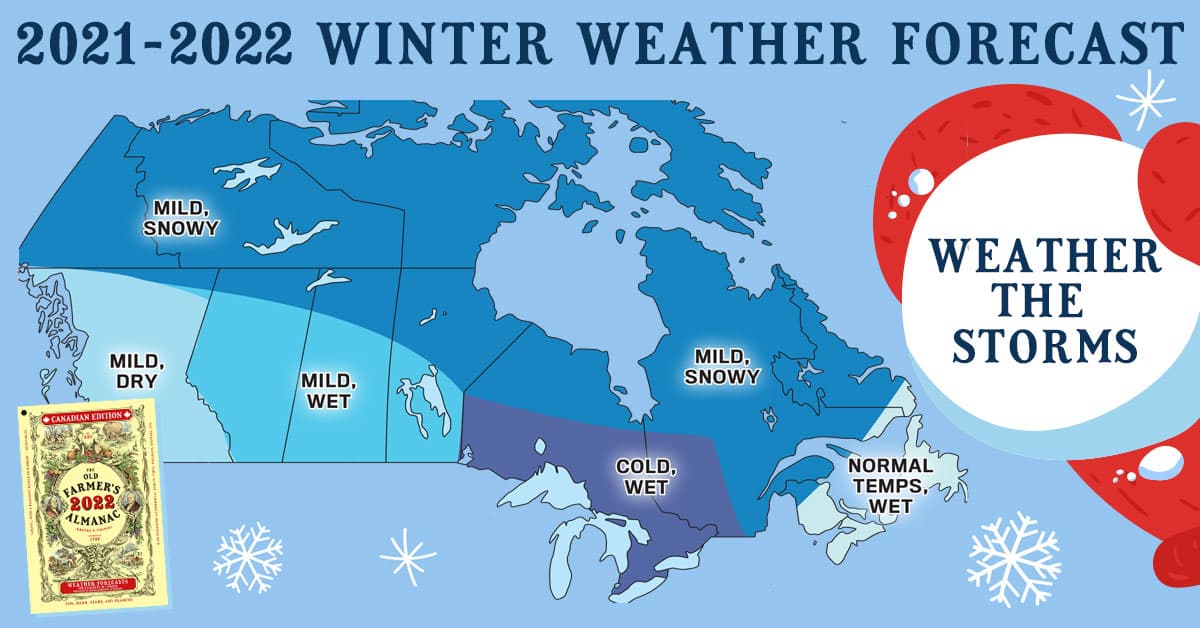
Guess what? It will snow this winter, I can promise you that. Yay! But what we all want to know is, how much? Well, the Old Farmer’s Almanac (not to be confused with the Farmer’s Almanac) has just released its long-range Canadian winter weather forecast for the 2021/22 season. For 230 years, the Almanac has been helping readers to prepare for winter’s worst with its 80 percent–accurate weather forecasts, in full, below:
Canadians should be prepared to “Weather the Storms,” as winter will be punctuated by a series of storms leaving them snowed in, sleeted on, slushed about, soaked, and otherwise generally soggy.
“This coming winter won’t be remarkable in terms of temperature, but for our Canadian friends who will end up just wanting to dry out, it will be a long season indeed.”
– Editor Janice Stillman
Snowfall will be above normal from western Atlantic Canada and eastern Quebec out through northern Ontario and the northern Prairies and into Nunavut, the Northwest Territories, and the Yukon. A series of back-to-back storms from mid-December to late January could leave Atlantic Canada snowed under for several weeks.
With slightly above-average temperatures throughout the season in all but the northernmost portions of the Prairies, winter storm clouds may sometimes bring rain or freezing rain across the nation’s midsection. However, this doesn’t mean that snow is completely out of the forecast: Major snowstorms are predicted for the Prairies in late November, mid-January, and early March.
This winter’s white-and-wet forecast will see colder-than-average temperatures from western Quebec into southern Ontario. While storms throughout the season are expected to bring plenty of rain, freezing rain, sleet, and flurries, snowfall itself will be below average overall.
The only place in Canada that won’t have many storms to weather is British Columbia, which should expect below-average precipitation and above-average temperatures throughout the season.

Atlantic Canada (Region 1)
Winter temperatures will be above normal in the north and near normal in the south, with the coldest periods in early to mid- and late January and early to mid- and late February. Precipitation will be below normal in the north and above in the south. Snowfall will be below normal in the east and above in the west, with the snowiest periods in early and mid-December, early to mid- and mid- to late January, and mid-March.
Southern Quebec (Region 2)
Winter temperatures will be slightly above normal in the east and below normal in the west, with the coldest periods in early and mid- to late December; early, mid-, and late January; and mid- to late February. Precipitation will be above normal, with snowfall above normal in the east and below normal in the west. The snowiest periods will be in mid-December, early January, and mid-February.
Southern Ontario (Region 3)
Winter will be colder than normal, with above-normal precipitation and below-normal snowfall. The coldest periods will be in late November, mid- to late December, and much of January, with the snowiest periods in mid- to late November, early December, and early January.
The Prairies (Region 4)
Winter will have above-normal temperatures and precipitation, with below-normal snowfall. The coldest periods will be from late December to early January and in mid- to late January, with the snowiest periods in late November, mid-January, and early March.
South British Columbia (Region 5)
Winter will be warmer and drier than normal, with below-normal snowfall. The coldest period will be from late December into early January, with the snowiest periods in late November, late December, and early January. April and May will have near-normal temperatures and be rainier than normal.
Yukon (Region 6)
Winter temperatures, precipitation, and snowfall will be above normal. The coldest periods will be from late November into early December, in late December, early January, and early February, with the snowiest periods in mid-November, early December, and mid- to late January.
Northwest Territories (Region 7)
Winter temperatures and precipitation will be above normal, on average, with generally below-normal snowfall. The coldest periods will be from late November into mid-December, in mid- to late January, and in early to mid-March. The snowiest periods will be in mid-November, mid- to late December, late January, and mid- to late March.
I would like to plan a road trip along the #1 from Winnipeg to Victoria in December/January. What can you tell me so I know whether or not to drive it?